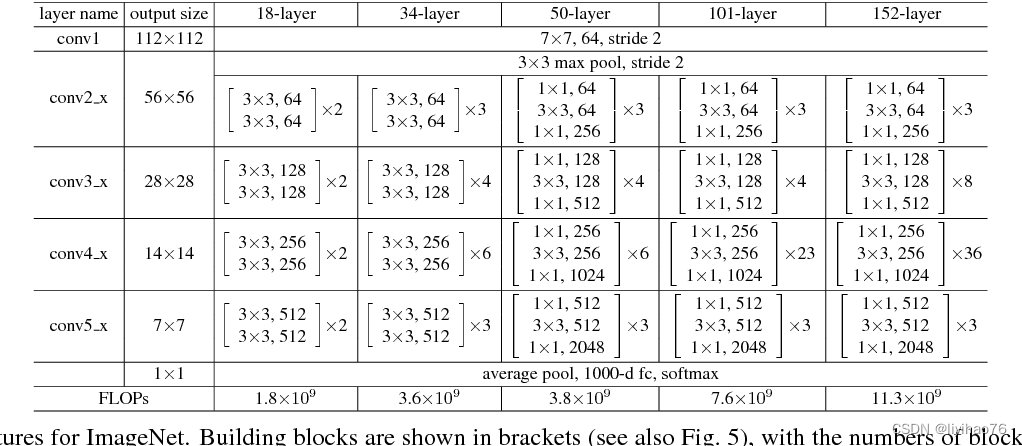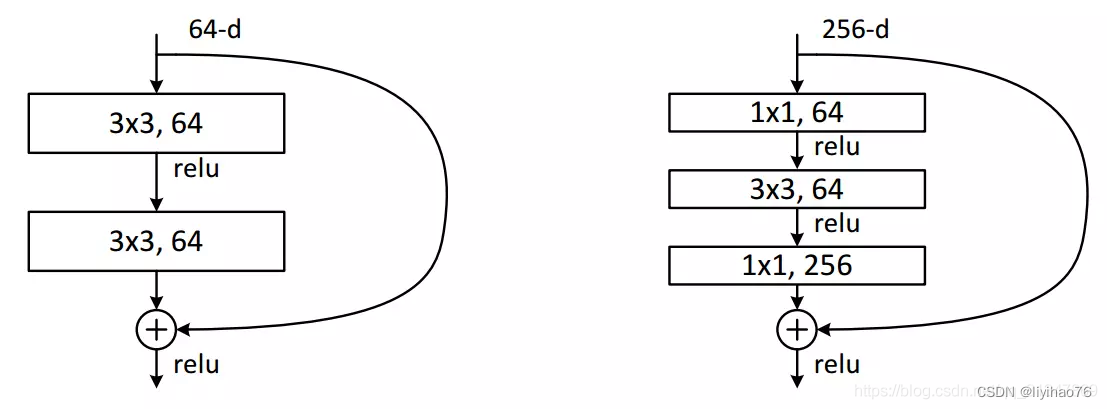-
[pytorch] 2D + 3D ResNet代码实现, 改写
本文只介绍resnet的代码实现,需要对resnet有基础的了解。代码参考pytorch官方实现,删除了一些非必要的判断条件,看起来更加简洁。z再次基础上,可以根据需要加入自己需要调整的参数,比如dilation,norm_layer等.参考
SOURCE CODE FOR TORCHVISION.MODELS.RESNET
2D ResNet50 网络结构搭建(PyTorch)
MedicalNet网络结构



左图:BasicBlock结构,用于resnet18/34
右图: Bottleneck结构,用于resnet50/101/1522D ResNet代码
import torch import torch.nn as nn- 1
- 2
首先是两种block的代码
#18/34 class BasicBlock_2d(nn.Module): expansion = 1 #每一个conv的卷积核个数的倍数 def __init__(self, in_channel, out_channel, stride=1, downsample=None):#downsample对应虚线残差结构 super(BasicBlock_2d, self).__init__() self.conv1 = nn.Conv2d(in_channels=in_channel, out_channels=out_channel, kernel_size=3, stride=stride, padding=1, bias=False) self.bn1 = nn.BatchNorm2d(out_channel)#BN处理 self.relu = nn.ReLU(inplace=True) # 尽量使用inplace操作flag,节省显存 self.conv2 = nn.Conv2d(in_channels=out_channel, out_channels=out_channel, kernel_size=3, stride=1, padding=1, bias=False) self.bn2 = nn.BatchNorm2d(out_channel) self.downsample = downsample def forward(self, x): identity = x #捷径上的输出值,为了保证原始输入与卷积后的输出层叠加时维度相同 if self.downsample is not None: identity = self.downsample(x) out = self.conv1(x) out = self.bn1(out) out = self.relu(out) out = self.conv2(out) out = self.bn2(out) out += identity out = self.relu(out) return out #50,101,152 class Bottleneck_2d(nn.Module): ''' :param in_channel: 输入block的之前的通道数 :param out_channel: 在block中间处理的时候的通道数 out_channel*self.extention:输出的维度 :param stride:卷积步长 :param downsample:在_make_layer函数中赋值,在resnet每层链接的第一个卷积层需要改变通道 如resnet50 conv2_x输出的256降低为128 conv3_x的输入 ''' expansion = 4 #4倍,类变量,可通过类名修改 def __init__(self, in_channel, out_channel, stride=1, downsample=None): super(Bottleneck_2d, self).__init__() self.conv1 = nn.Conv2d(in_channels=in_channel, out_channels=out_channel, kernel_size=1, stride=1, bias=False) # squeeze channels self.bn1 = nn.BatchNorm2d(out_channel) # ----------------------------------------- self.conv2 = nn.Conv2d(in_channels=out_channel, out_channels=out_channel, kernel_size=3, stride=stride, bias=False, padding=1) self.bn2 = nn.BatchNorm2d(out_channel) # ----------------------------------------- self.conv3 = nn.Conv2d(in_channels=out_channel, out_channels=out_channel*self.expansion,#输出*4 kernel_size=1, stride=1, bias=False) # unsqueeze channels self.bn3 = nn.BatchNorm2d(out_channel*self.expansion) self.relu = nn.ReLU(inplace=True) self.downsample = downsample def forward(self, x): identity = x if self.downsample is not None: identity = self.downsample(x) out = self.conv1(x) out = self.bn1(out) out = self.relu(out) out = self.conv2(out) out = self.bn2(out) out = self.relu(out) out = self.conv3(out) out = self.bn3(out) out += identity # 残差连接 out = self.relu(out) return out- 1
- 2
- 3
- 4
- 5
- 6
- 7
- 8
- 9
- 10
- 11
- 12
- 13
- 14
- 15
- 16
- 17
- 18
- 19
- 20
- 21
- 22
- 23
- 24
- 25
- 26
- 27
- 28
- 29
- 30
- 31
- 32
- 33
- 34
- 35
- 36
- 37
- 38
- 39
- 40
- 41
- 42
- 43
- 44
- 45
- 46
- 47
- 48
- 49
- 50
- 51
- 52
- 53
- 54
- 55
- 56
- 57
- 58
- 59
- 60
- 61
- 62
- 63
- 64
- 65
- 66
- 67
- 68
- 69
- 70
- 71
- 72
- 73
- 74
- 75
- 76
- 77
- 78
- 79
- 80
class ResNet2d(nn.Module): """ __init__ block: 堆叠的基本模块 block_num: 基本模块堆叠个数,是一个list,对于resnet50=[3,4,6,3] num_classes: 全连接之后的分类特征维度 _make_layer block: 堆叠的基本模块 channel: 每个stage中堆叠模块的第一个卷积的卷积核个数,对resnet50分别是:64,128,256,512 block_num: 当期stage堆叠block个数 stride: 默认卷积步长 """ def __init__(self, block, blocks_num, num_classes=1000, include_top=True):#block残差结构 include_top为了之后搭建更加复杂的网络 super(ResNet2d, self).__init__() self.include_top = include_top self.in_channel = 64 # conv1的输出维度 self.conv1_2d = nn.Conv2d(3, self.in_channel, kernel_size=7, stride=2, padding=3, bias=False) self.bn1_2d = nn.BatchNorm2d(self.in_channel) self.relu_2d = nn.ReLU(inplace=True) self.maxpool_2d = nn.MaxPool2d(kernel_size=3, stride=2, padding=1) # H/2,W/2。C不变 self.layer1_2d = self._make_layer(block, 64, blocks_num[0]) # H,W不变。downsample控制的shortcut,out_channel=64x4=256 self.layer2_2d = self._make_layer(block, 128, blocks_num[1], stride=2) # H/2, W/2。downsample控制的shortcut,out_channel=128x4=512 self.layer3_2d = self._make_layer(block, 256, blocks_num[2], stride=2) # H/2, W/2。downsample控制的shortcut,out_channel=256x4=1024 self.layer4_2d = self._make_layer(block, 512, blocks_num[3], stride=2) # H/2, W/2。downsample控制的shortcut,out_channel=512x4=2048 if self.include_top: self.avgpool = nn.AdaptiveAvgPool2d((1, 1)) # output size = (1, 1)自适应 self.fc = nn.Linear(512 * block.expansion, num_classes) for m in self.modules():# 权重初始化 if isinstance(m, nn.Conv2d): nn.init.kaiming_normal_(m.weight, mode='fan_out', nonlinearity='relu') elif isinstance(m, (nn.BatchNorm2d, nn.GroupNorm)): nn.init.constant_(m.weight, 1) nn.init.constant_(m.bias, 0) def _make_layer(self, block, channel, block_num, stride=1): """ 第一个输入参数 block 选择要使用的模块是 BasicBlock 还是 Bottleneck 类, 第二个输入参数 channel 是该模块的输出通道数, 第三个输入参数 block_num 是每个 blocks 中包含多少个 residual 子结构。 """ downsample = None # 用于控制shorcut路的 if stride != 1 or self.in_channel != channel * block.expansion: # 对resnet50:conv2中特征图尺寸H,W不需要下采样/2,但是通道数x4, # 因此shortcut通道数也需要x4。对其余conv3,4,5,既要特征图尺寸H,W/2,又要shortcut维度x4 downsample = nn.Sequential( nn.Conv2d(self.in_channel, channel * block.expansion, kernel_size=1, stride=stride, bias=False), # out_channels决定输出通道数x4,stride决定特征图尺寸H,W/2 nn.BatchNorm2d(channel * block.expansion)) layers = [] layers.append(block(self.in_channel, channel, downsample=downsample, stride=stride)) # 定义convi_x中的第一个残差块,只有第一个需要设置downsample和stride self.in_channel = channel * block.expansion # 在下一次调用_make_layer函数的时候,self.in_channel已经x4 for _ in range(1, block_num): # 通过循环堆叠其余残差块(堆叠了剩余的block_num-1个) layers.append(block(self.in_channel, channel)) return nn.Sequential(*layers) # '*'的作用是将list转换为非关键字参数传入 def forward(self, x): x = self.conv1_2d(x) x = self.bn1_2d(x) x = self.relu_2d(x) x = self.maxpool_2d(x) x = self.layer1_2d(x) x = self.layer2_2d(x) x = self.layer3_2d(x) x = self.layer4_2d(x) if self.include_top: x = self.avgpool(x) x = torch.flatten(x, 1) x = self.fc(x) return x- 1
- 2
- 3
- 4
- 5
- 6
- 7
- 8
- 9
- 10
- 11
- 12
- 13
- 14
- 15
- 16
- 17
- 18
- 19
- 20
- 21
- 22
- 23
- 24
- 25
- 26
- 27
- 28
- 29
- 30
- 31
- 32
- 33
- 34
- 35
- 36
- 37
- 38
- 39
- 40
- 41
- 42
- 43
- 44
- 45
- 46
- 47
- 48
- 49
- 50
- 51
- 52
- 53
- 54
- 55
- 56
- 57
- 58
- 59
- 60
- 61
- 62
- 63
- 64
- 65
- 66
- 67
- 68
- 69
- 70
- 71
- 72
- 73
- 74
- 75
- 76
- 77
- 78
- 79
- 80
使用resnet50进行3分类
resnet50_2d = ResNet2d(Bottleneck_2d, [3, 4, 6, 3], num_classes=3,include_top=True) x=torch.randn(1,3,448,448) X=resnet50_2d(x) print(X.shape) # torch.Size([1, 3])- 1
- 2
- 3
- 4
- 5
网络结构可视化
import netron import torch.onnx modelData ='demo.onnx' # 定义模型数据保存的路径 torch.onnx.export(resnet50_2d, x, modelData) # 将 pytorch 模型以 onnx 格式导出并保存 onnx.save(onnx.shape_inference.infer_shapes(onnx.load(modelData)), modelData) netron.start(modelData) # 输出网络结构- 1
- 2
- 3
- 4
- 5
- 6
2D ResNet的backbones
resnet18_2d = ResNet2d(BasicBlock_2d, [2, 2, 2, 2], include_top=False) resnet34_2d = ResNet2d(BasicBlock_2d, [3, 4, 6, 3], include_top=False) resnet50_2d = ResNet2d(Bottleneck_2d, [3, 4, 6, 3], include_top=False) resnet101_2d = ResNet2d(Bottleneck_2d, [3, 4, 23, 3], include_top=False) resnet152_2d = ResNet2d(Bottleneck_2d, [3, 8, 36, 3], include_top=False)- 1
- 2
- 3
- 4
- 5
3D ResNet代码
3D ResNet的实现参考腾讯的MedicalNet: Med3D: Transfer Learning for 3D Medical Image Analysis.
import torch import torch.nn as nn import torch.nn.functional as F from torch.autograd import Variable import math from functools import partial- 1
- 2
- 3
- 4
- 5
- 6
def conv3x3x3(in_planes, out_planes, stride=1, dilation=1): # 3x3x3 convolution with padding return nn.Conv3d( in_planes, out_planes, kernel_size=3, dilation=dilation, stride=stride, padding=dilation, bias=False) def downsample_basic_block(x, planes, stride, no_cuda=False): out = F.avg_pool3d(x, kernel_size=1, stride=stride) zero_pads = torch.Tensor( out.size(0), planes - out.size(1), out.size(2), out.size(3), out.size(4)).zero_() if not no_cuda: if isinstance(out.data, torch.cuda.FloatTensor): zero_pads = zero_pads.cuda() out = Variable(torch.cat([out.data, zero_pads], dim=1)) return out class BasicBlock(nn.Module): expansion = 1 def __init__(self, inplanes, planes, stride=1, dilation=1, downsample=None): super(BasicBlock, self).__init__() self.conv1 = conv3x3x3(inplanes, planes, stride=stride, dilation=dilation) self.bn1 = nn.BatchNorm3d(planes) self.relu = nn.ReLU(inplace=True) self.conv2 = conv3x3x3(planes, planes, dilation=dilation) self.bn2 = nn.BatchNorm3d(planes) self.downsample = downsample self.stride = stride self.dilation = dilation def forward(self, x): residual = x out = self.conv1(x) out = self.bn1(out) out = self.relu(out) out = self.conv2(out) out = self.bn2(out) if self.downsample is not None: residual = self.downsample(x) out += residual out = self.relu(out) return out class Bottleneck(nn.Module): expansion = 4 def __init__(self, inplanes, planes, stride=1, dilation=1, downsample=None): super(Bottleneck, self).__init__() self.conv1 = nn.Conv3d(inplanes, planes, kernel_size=1, bias=False) self.bn1 = nn.BatchNorm3d(planes) self.conv2 = nn.Conv3d( planes, planes, kernel_size=3, stride=stride, dilation=dilation, padding=dilation, bias=False) self.bn2 = nn.BatchNorm3d(planes) self.conv3 = nn.Conv3d(planes, planes * 4, kernel_size=1, bias=False) self.bn3 = nn.BatchNorm3d(planes * 4) self.relu = nn.ReLU(inplace=True) self.downsample = downsample self.stride = stride self.dilation = dilation def forward(self, x): residual = x out = self.conv1(x) out = self.bn1(out) out = self.relu(out) out = self.conv2(out) out = self.bn2(out) out = self.relu(out) out = self.conv3(out) out = self.bn3(out) if self.downsample is not None: residual = self.downsample(x) out += residual out = self.relu(out) return out- 1
- 2
- 3
- 4
- 5
- 6
- 7
- 8
- 9
- 10
- 11
- 12
- 13
- 14
- 15
- 16
- 17
- 18
- 19
- 20
- 21
- 22
- 23
- 24
- 25
- 26
- 27
- 28
- 29
- 30
- 31
- 32
- 33
- 34
- 35
- 36
- 37
- 38
- 39
- 40
- 41
- 42
- 43
- 44
- 45
- 46
- 47
- 48
- 49
- 50
- 51
- 52
- 53
- 54
- 55
- 56
- 57
- 58
- 59
- 60
- 61
- 62
- 63
- 64
- 65
- 66
- 67
- 68
- 69
- 70
- 71
- 72
- 73
- 74
- 75
- 76
- 77
- 78
- 79
- 80
- 81
- 82
- 83
- 84
- 85
- 86
- 87
- 88
- 89
- 90
- 91
- 92
- 93
- 94
- 95
- 96
class ResNet_3d(nn.Module): def __init__(self, block, layers, num_classes=1000, shortcut_type='B', no_cuda = False, include_top=True): super(ResNet_3d, self).__init__() self.inplanes = 64 self.no_cuda = no_cuda self.include_top = include_top self.conv1 = nn.Conv3d( 1, 64, kernel_size=7, stride=(2, 2, 2), padding=(3, 3, 3), bias=False) self.bn1 = nn.BatchNorm3d(64) self.relu = nn.ReLU(inplace=True) self.maxpool = nn.MaxPool3d(kernel_size=(3, 3, 3), stride=2, padding=1) self.layer1 = self._make_layer(block, 64, layers[0], shortcut_type) self.layer2 = self._make_layer( block, 128, layers[1], shortcut_type, stride=2) self.layer3 = self._make_layer( block, 256, layers[2], shortcut_type, stride=2) self.layer4 = self._make_layer( block, 512, layers[3], shortcut_type, stride=2) if self.include_top: self.avgpool = nn.AdaptiveAvgPool3d((1, 1, 1)) # output size = (1, 1)自适应 self.fc = nn.Linear(512 * block.expansion, num_classes) for m in self.modules(): if isinstance(m, nn.Conv3d): m.weight = nn.init.kaiming_normal(m.weight, mode='fan_out') elif isinstance(m, nn.BatchNorm3d): m.weight.data.fill_(1) m.bias.data.zero_() def _make_layer(self, block, planes, blocks, shortcut_type, stride=1, dilation=1): downsample = None if stride != 1 or self.inplanes != planes * block.expansion: if shortcut_type == 'A': downsample = partial( downsample_basic_block, planes=planes * block.expansion, stride=stride, no_cuda=self.no_cuda) else: downsample = nn.Sequential( nn.Conv3d( self.inplanes, planes * block.expansion, kernel_size=1, stride=stride, bias=False), nn.BatchNorm3d(planes * block.expansion)) layers = [] layers.append(block(self.inplanes, planes, stride=stride, downsample=downsample)) self.inplanes = planes * block.expansion for i in range(1, blocks): layers.append(block(self.inplanes, planes)) return nn.Sequential(*layers) def forward(self, x): x = self.conv1(x) x = self.bn1(x) x = self.relu(x) x = self.maxpool(x) x = self.layer1(x) x = self.layer2(x) x = self.layer3(x) x = self.layer4(x) if self.include_top: x = self.avgpool(x) x = torch.flatten(x, 1) x = self.fc(x) return x- 1
- 2
- 3
- 4
- 5
- 6
- 7
- 8
- 9
- 10
- 11
- 12
- 13
- 14
- 15
- 16
- 17
- 18
- 19
- 20
- 21
- 22
- 23
- 24
- 25
- 26
- 27
- 28
- 29
- 30
- 31
- 32
- 33
- 34
- 35
- 36
- 37
- 38
- 39
- 40
- 41
- 42
- 43
- 44
- 45
- 46
- 47
- 48
- 49
- 50
- 51
- 52
- 53
- 54
- 55
- 56
- 57
- 58
- 59
- 60
- 61
- 62
- 63
- 64
- 65
- 66
- 67
- 68
- 69
- 70
- 71
- 72
- 73
- 74
- 75
- 76
- 77
- 78
- 79
- 80
- 81
- 82
- 83
- 84
- 85
- 86
- 87
- 88
- 89
使用3D Resnet34进行3分类
resnet34_3d = ResNet_3d(BasicBlock, [3, 4, 6, 3],shortcut_type='A',no_cuda=False,num_classes=3,include_top=True) x=torch.randn(1,1,256,224,164) X=resnet34_3d(x) print(X.shape) # torch.Size([1, 3])- 1
- 2
- 3
- 4
- 5
使用3D Resnet50进行3分类
resnet50_3d = ResNet_3d(Bottleneck, [3, 4, 6, 3],shortcut_type='B',no_cuda=False,num_classes=3,include_top=True) x=torch.randn(1,1,256,224,164) X=resnet50_3d(x) print(X.shape) # torch.Size([1, 3])- 1
- 2
- 3
- 4
- 5
可视化
import netron import torch.onnx modelData ='best.onnx' # 定义模型数据保存的路径 torch.onnx.export(resnet50_3d, x, modelData) # 将 pytorch 模型以 onnx 格式导出并保存 onnx.save(onnx.shape_inference.infer_shapes(onnx.load(modelData)), modelData) netron.start(modelData) # 输出网络结构- 1
- 2
- 3
- 4
- 5
- 6
-
相关阅读:
Windows安装Docker环境
Flutter快学快用08 单元测试:Flutter 应用单元测试,提升代码质量
MySQL 索引简介
一文彻底吃透自动化测试框架所有知识,看完就可以直接独立搭建自动化测试框架
【JavaSE】抽象类和接口重点语法知识汇总(附有代码)
深挖Cerebras:世界上最大AI芯片的架构设计
Java序列化为什么必须实现 Serializable 接口
Termius for Mac v8.4.0激活版下载
改进YOLOv5、YOLOv7系列:首发最新改进一种强大性能的全新架构(顶会2022), 该架构精度超越TPH-YOLOv5, 新范式高效涨点
jupyter使用conda虚拟环境操作步骤
- 原文地址:https://blog.csdn.net/qq_38736504/article/details/127397339
